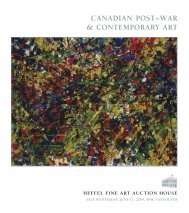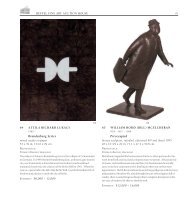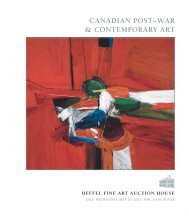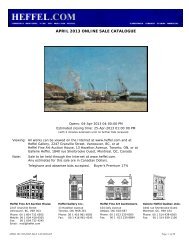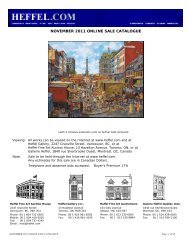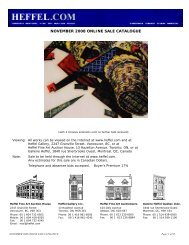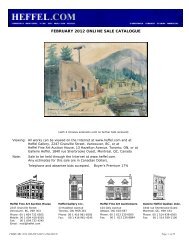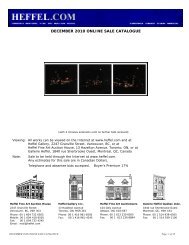CANADIAN POST~WAR & CONTEMPORARY ART - Heffel
CANADIAN POST~WAR & CONTEMPORARY ART - Heffel
CANADIAN POST~WAR & CONTEMPORARY ART - Heffel
You also want an ePaper? Increase the reach of your titles
YUMPU automatically turns print PDFs into web optimized ePapers that Google loves.
HEFFEL FINE <strong>ART</strong> AUCTION HOUSE 19<br />
10 WILLIAM KURELEK<br />
ARCA OC OSA 1927 ~ 1977<br />
After the Blizzard in Manitoba<br />
mixed media on board, initialed and dated 1967<br />
and on verso signed, titled, dated and inscribed<br />
donated to Mrs. Gerald Hollyer and for Kingsmill<br />
Company in gratitude for services renderened [sic]<br />
in purchase of a house 1965<br />
20 x 28 1/2 in, 50.8 x 72.4 cm<br />
PROVENANCE:<br />
Acquired directly from the Artist, 1967<br />
Private Collection, Toronto<br />
LITERATURE:<br />
Philip Earnshaw, director, The Passion of Christ According to Saint Matthew:<br />
William Kurelek, film, 2005<br />
In addition to being one of Canada’s most accomplished and interesting<br />
artists, William Kurelek wrote and illustrated many award~winning<br />
children’s books. His joyous explorations of childhood themes in his art<br />
made this a natural extension of his work. And while his art and writings<br />
can be enjoyed for their simple and exuberant content, to do so is to miss a<br />
deeper layer of meaning. A child of the Depression and the oldest of seven<br />
children in a hard~working Ukrainian Orthodox immigrant family, his<br />
youth was spent on the open prairie of Manitoba. He showed an early<br />
aptitude for drawing, but this career path was not supported by his<br />
farming parents, particularly his father. Their troubled relationship was<br />
“an agony to them both”, and Kurelek would ultimately suffer depression<br />
and suicidal despair. Largely self~taught, he attended the Ontario College<br />
of Art briefly, but was drifting and searching for a path. He traveled to San<br />
Miguel de Allende, Mexico, where he discovered the Nicolaïdes method<br />
of drawing, which he would later credit with helping him discover his<br />
own style. Keenly interested in religious iconography and wanting to see<br />
the world’s great art, he traveled to England in the early 1950s. There, his<br />
mental health failed and he was treated for depression. While in the<br />
hospital, he painted the cathartic masterwork The Maze, wherein he<br />
explores in painful detail the unhappiness in his life. He achieved success<br />
as a painter as a result of his pain, and in an interesting twist, a pious<br />
Catholic nurse who cared for him during this time inspired Kurelek to<br />
revisit religion, and he converted to Catholicism in 1957.<br />
Returning to Canada as an established painter, he explored the issues in<br />
his life through his art. His subtle blend of everyday events and religious<br />
themes are engaging on many levels. Presented to us as Canadian scenes,<br />
Old World religious imagery is everywhere in his work. Families walk to<br />
church, priests come for dinner, mothers and sons appear together in<br />
harmony. The scenes are full of the simple beauty of rural life ~ families at<br />
rest and play, celebrating birthdays, tending animals, doing the mundane<br />
chores. Additionally, these everyday acts are given deeper meaning in the<br />
details and surface treatment of the works. One might compare the<br />
surface of Kurelek’s paintings, which are hard and smooth, often<br />
glass~like, to inlaid enamel and religious icons of the sixteenth and<br />
seventeenth centuries. His unique method of incising dried but uncured<br />
paint with a ballpoint pen, and using coloured pencils to etch, scratch and<br />
draw on the paint’s surface, furthers this effect. The contrast of the rich<br />
surface and the often simple subjects makes for an interesting<br />
juxtaposition of form and image. This is particularly the case in After the<br />
Blizzard in Manitoba where we see a group of children playing wildly on<br />
the cliff of snow cut by a plough after a heavy blizzard. The scene is largely<br />
comprised of snow, but handled with Kurelek’s unique style, the vast<br />
whiteness itself is a dance of light and shadow as the colour of the sky<br />
repeats in the children’s snowsuits and the distant sleigh. The scene is<br />
almost fantastical, as the snow blankets the telephone poles almost to<br />
their tops which jut, cross~like, from the surface of the massive drift.<br />
Without worry of injury, children slide, tunnel and climb. Only the dog<br />
hesitates to bound into the fray. The work is absolutely joyous ~ children<br />
playing in the snow ~ yet, we are reminded by Kurelek of the brevity of<br />
youth as the adult in the scene heads out of the picture in a sleigh, his back<br />
to the fun, intent on some serious adult purpose.<br />
ESTIMATE: $50,000 ~ 70,000



